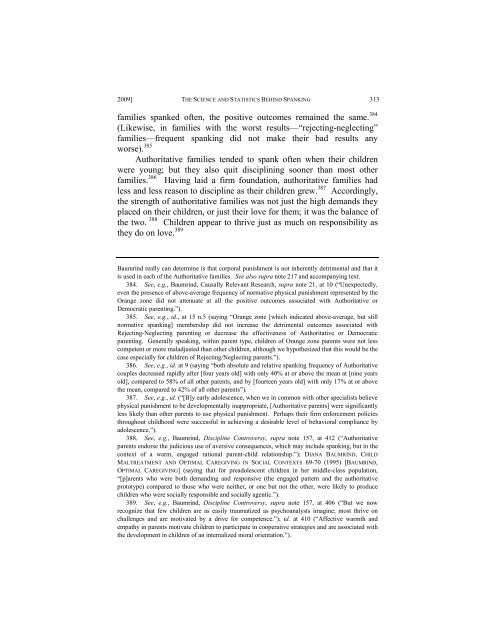The Science and Statistics Behind Spanking Suggests that
The Science and Statistics Behind Spanking Suggests that
The Science and Statistics Behind Spanking Suggests that
Create successful ePaper yourself
Turn your PDF publications into a flip-book with our unique Google optimized e-Paper software.
11-FULLER_FINAL_AFTERPROOF.DOC 2/17/2009 8:50 AM<br />
2009] THE SCIENCE AND STATISTICS BEHIND SPANKING 313<br />
families spanked often, the positive outcomes remained the same. 384<br />
(Likewise, in families with the worst results—“rejecting-neglecting”<br />
families—frequent spanking did not make their bad results any<br />
worse). 385<br />
Authoritative families tended to spank often when their children<br />
were young; but they also quit disciplining sooner than most other<br />
families. 386 Having laid a firm foundation, authoritative families had<br />
less <strong>and</strong> less reason to discipline as their children grew. 387 Accordingly,<br />
the strength of authoritative families was not just the high dem<strong>and</strong>s they<br />
placed on their children, or just their love for them; it was the balance of<br />
the two. 388 Children appear to thrive just as much on responsibility as<br />
they do on love. 389<br />
Baumrind really can determine is <strong>that</strong> corporal punishment is not inherently detrimental <strong>and</strong> <strong>that</strong> it<br />
is used in each of the Authoritative families. See also supra note 217 <strong>and</strong> accompanying text.<br />
384. See, e.g., Baumrind, Causally Relevant Research, supra note 21, at 10 (“Unexpectedly,<br />
even the presence of above-average frequency of normative physical punishment represented by the<br />
Orange zone did not attenuate at all the positive outcomes associated with Authoritative or<br />
Democratic parenting.”).<br />
385. See, e.g., id., at 15 n.5 (saying “Orange zone [which indicated above-average, but still<br />
normative spanking] membership did not increase the detrimental outcomes associated with<br />
Rejecting-Neglecting parenting or decrease the effectiveness of Authoritative or Democratic<br />
parenting. Generally speaking, within parent type, children of Orange zone parents were not less<br />
competent or more maladjusted than other children, although we hypothesized <strong>that</strong> this would be the<br />
case especially for children of Rejecting/Neglecting parents.”).<br />
386. See, e.g., id. at 9 (saying “both absolute <strong>and</strong> relative spanking frequency of Authoritative<br />
couples decreased rapidly after [four years old] with only 40% at or above the mean at [nine years<br />
old], compared to 58% of all other parents, <strong>and</strong> by [fourteen years old] with only 17% at or above<br />
the mean, compared to 42% of all other parents”).<br />
387. See, e.g., id. (“[B]y early adolescence, when we in common with other specialists believe<br />
physical punishment to be developmentally inappropriate, [Authoritative parents] were significantly<br />
less likely than other parents to use physical punishment. Perhaps their firm enforcement policies<br />
throughout childhood were successful in achieving a desirable level of behavioral compliance by<br />
adolescence.”).<br />
388. See, e.g., Baumrind, Discipline Controversy, supra note 157, at 412 (“Authoritative<br />
parents endorse the judicious use of aversive consequences, which may include spanking, but in the<br />
context of a warm, engaged rational parent-child relationship.”); DIANA BAUMRIND, CHILD<br />
MALTREATMENT AND OPTIMAL CAREGIVING IN SOCIAL CONTEXTS 69-70 (1995) [BAUMRIND,<br />
OPTIMAL CAREGIVING] (saying <strong>that</strong> for preadolescent children in her middle-class population,<br />
“[p]arents who were both dem<strong>and</strong>ing <strong>and</strong> responsive (the engaged pattern <strong>and</strong> the authoritative<br />
prototype) compared to those who were neither, or one but not the other, were likely to produce<br />
children who were socially responsible <strong>and</strong> socially agentic.”).<br />
389. See, e.g., Baumrind, Discipline Controversy, supra note 157, at 406 (“But we now<br />
recognize <strong>that</strong> few children are as easily traumatized as psychoanalysts imagine; most thrive on<br />
challenges <strong>and</strong> are motivated by a drive for competence.”); id. at 410 (“Affective warmth <strong>and</strong><br />
empathy in parents motivate children to participate in cooperative strategies <strong>and</strong> are associated with<br />
the development in children of an internalized moral orientation.”).

















